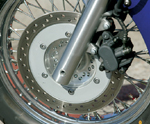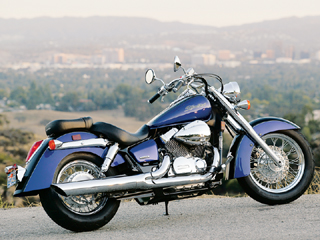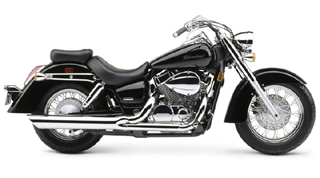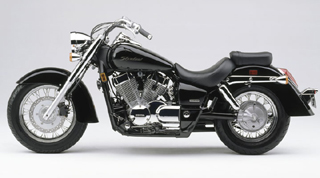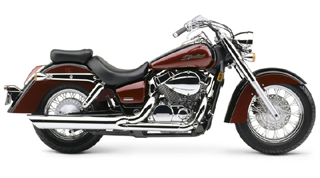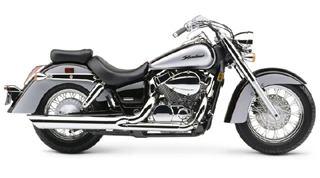 Cruisers may represent the more traditional end of the
motorcycle design spectrum, but even relatively low-key V-twins need
facelifts and tummy tucks every so often to catch the eye of the elusive
consumer. The 750cc cruiser segment is a prime example of reliable
designs built to a price point, and a market niche that has been
particularly lucrative for Honda. So lucrative, in fact, that it's been
the company's best-selling streetbike category for three years straight.
Regardless, the 750cc Shadow line has been looking a bit long in the
tooth lately. In an aggressive move, Honda cleaned out the stable,
throwing the venerable 750cc A.C.E. and 750 Spirit models into the
scrapheap. The Aero is the only kid on the old middleweight V-twin block
this year.
Cruisers may represent the more traditional end of the
motorcycle design spectrum, but even relatively low-key V-twins need
facelifts and tummy tucks every so often to catch the eye of the elusive
consumer. The 750cc cruiser segment is a prime example of reliable
designs built to a price point, and a market niche that has been
particularly lucrative for Honda. So lucrative, in fact, that it's been
the company's best-selling streetbike category for three years straight.
Regardless, the 750cc Shadow line has been looking a bit long in the
tooth lately. In an aggressive move, Honda cleaned out the stable,
throwing the venerable 750cc A.C.E. and 750 Spirit models into the
scrapheap. The Aero is the only kid on the old middleweight V-twin block
this year.
A Honda rep told us consumers were asked what elements
were most essential when considering new bikes in this category. Price,
styling and maintenance concerns consistently came up as significantly
important to potential buyers. It's no surprise, then, that the new Aero
fulfills all three requirements, in addition to bringing enhanced style
and power to the 750 class.
The heart of the beast hasn't changed much from that of
its forebears. Honda's new 2004 Aero inherits an updated version of the
six-valve 745cc V-twin that powered the two retired 750s. That design
brings a single overhead camshaft, two spark plugs per cylinder and three
valves per cylinder. Instead of the two carbs the A.C.E. and Spirit
housed, however, the Aero utilizes a single 34mm constant-velocity Keihin
unit for easy adjustability and what Honda calls an enhanced V-twin vibe.
At the other end of the combustion process is a sleek
2-into-1 exhaust system that features a livelier bark than the mufflers
of previous Shadows. The system encloses two fully independent pipe and
silencer sets in a single long, large-diameter case, and an air-injection
system reduces emissions by injecting air into the exhaust ports to
ensure complete combustion. Combustion chambers also get a bump in
compression from 9.0:1 to 9.6:1, and the airbox sports a new shape to
improve intake efficiency. The Aero comes equipped with a wide-ratio
five-speed transmission and an aluminum radiator mounted between the
frame rails to maintain consistent engine temperature.

Honda took styling cues into account on this machine as
well, and a long and low look complements the spacious ergonomics and
sweeping bar. A new steel-tube frame design with lower frame rails places
the seat height at a subterranean 25.9 inches, lower than either of the
750s the Aero replaces and half an inch lower than Honda's own 250cc
Rebel. Honda wants the '04 Aero to evoke the '50s and '60s, with deep,
valanced fenders and a stylish tank cover, but you'd have to squint
pretty hard to get that feeling. It's more a suggestion of an era.
Naturally, chrome highlights abound, from the cylinder-head cover to the
instrument housing.
But the real news here is the change in the powertrain.
The A.C.E. and Spirit's bargain-basement chain drive was tossed out and
replaced with an efficient, low-maintenance shaft drive for the Aero. But
surely Honda had one eye on the competition, too. Kawasaki's Vulcan 750,
Suzuki's 800s and Yamaha's 650 V-Stars all use shaft final drive. It was
an obvious direction for Honda.

The bike's 52-degree V-twin mill starts fairly easily,
though occasional deployment of the left-side choke knob speeds things up
on cold mornings. Throw a leg over and settle onto the roomy saddle,
which places you a mere two feet off the ground—giving plenty of
confidence for beginning or shorter riders. The broad pilot's perch
provides plenty of room for butt placement and puts you at a perfect
level with the wide, rubber-mounted handlebar curved to fall close to the
rider's hands. Passengers won't be as happy out back, however; the
pillion, though detachable, is narrow, and the pegs are too high to allow
much comfort. A pair of forward-set aluminum footpegs provides additional
room for pilots to stretch out, though these are tilted too far to feel
natural, and your heel can touch down on sharp turns.

The initial getaway is smooth thanks to an easily
accessible clutch lever and silky engagement. Shifting is positive, with
the requisite clunk in first gear. Once underway, the Shadow Aero pulses
like a V-twin, but one with flawless carburetion and an agreeable exhaust
note to boot. The engine does radiate some vibration, felt mostly through
the pegs, but this never develops into anything more than an annoyance.
Throttle response is fairly crisp for a bike of this class, and the
torque pull off the light is surprisingly forceful.
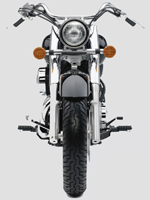
At low speeds, the 550-pound Aero comports itself
admirably, with light steering and terrific leverage in turns thanks to
the wide bar. At 64.5 inches, the wheelbase is somewhere between the
A.C.E. (63.6) and Spirit's (64.8) dimensions, which results in a steady,
predictable ride. Ground clearance is better than expected considering
the low seat height, but we were less than impressed with the ride
quality along sharply irregular roads. Although the dual rear shocks have
five-position preload adjustability, there are only 3.5 inches of travel
to play with out back, resulting in a somewhat underdamped feel. The 41mm
fork offers more neutral handling up front, however, with 4.6 inches of
wheel travel for the fat 120/90-17 front tire and a 4mm fork brace to
enhance rigidity.
A single 296mm drilled rotor gripped by a twin-piston
caliper provides controllable stopping power, though substantial effort
is necessary at the brake lever, and you should be prepared to employ the
180mm rear drum unit, too. The levers themselves are easy to access even
for small hands, and readily engaged. The Aero's retro styling flows into
details such as spoked wheels (with tube-type tires, unfortunately), wide
chrome rims and a large 3.7-gallon fuel tank. On most rides in the city,
we were able to milk more than 135 miles from a single tank of gas. The
Aero shines on urban runs. The rear shocks feature eye-catching chrome
covers, and the fork is also encased in large-diameter chromed steel
shrouds.
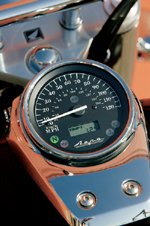
The speedometer peeks out of an attractive chrome
instrument housing set into the front of the fuel tank in classic retro
style. Instrumentation is what you'd expect from a bike at this level—a
speedo and an LCD tripmeter/odometer combination. A handsome, classically
styled headlight brings up the front, providing better-than-average
lighting with a 60/55-watt halogen bulb. We also liked the steering head
and helmet lock features for the added convenience and security they
allow riders.
There are a few unsightly details on the Aero, like the
front wiring, chintzy turn signals and tank seam, but overall, this
newest Shadow is a good deal. Perhaps the best aspect is its
affordability—a competitive sticker price of $6199 puts it on the same
playing field as Yamaha's popular V-Star 650 and Kawasaki's Vulcan 800,
which both offer shaft drive and a sub-$6200 price. The Aero is available
in solid black or solid dark red as well as three two-tone color options:
black/silver, black/red and black/blue. Honda also says it will provide a
raft of accessories to support the Aero, including windshield, saddlebag
brackets, a backrest and a light bar.
For the thousands of loyal A.C.E. customers, an
Aero-only 750 class may seem a rash move, but we think it's about time
Honda cleaned house. With modern features, sweet ergonomics and an
agreeable tariff, this new entry is headed for success and worthy of the
same kind of following the Shadow line became famous for.
Riding Positions
Art Friedman:
Honda has given its popular middleweight shaft drive— a welcome
improvement73151about the same time that buyers seem to have moved on to
belt drive as their preferred form of final drive. Belt might have been a
better choice here too, since it is equally quiet, clean and
maintenance-free but eliminates the jacking of a shaft and—more to the
point on a 750—is lighter and cheaper. But either drive system is better
than the messy chain, which riders generally fail to lube frequently
enough.
The Aero is a nice enough motorcycle, though my 220
pounds overwhelm the suspension on a bumpy road. Lighter riders shopping
for a machine in this range should take take note, however. The Suzuki
Volusia and Yamaha V-Star have new competition.
—Art Friedman
Belt Friedman at
Art.Friedman@primedia.com
or at
ArtoftheMotorcycle@hotmail.com.
Andrew Cherney:
It's hard to believe the 750 class is now considered "entry-level," but
that's what we're looking at here. Even newbies appreciate upgrades,
however, and the Aero's shaft drive brings Honda up to par with other
manufacturers in the class. The new Shadow 750's a welcome improvement
over Honda's plain-jane Spirit 750 in terms of style and value, but A.C.E.
fans may not be exactly thrilled with the abrupt way their bike was
dropped from the lineup this year. Another caveat: the Aero's rock-bottom
seat height might appeal hugely to beginners, but pilots taller than six
feet should definitely look elsewhere. —Andy
Cherney
Size up Cherney at
Andy.Cherney@primedia.com.
Specifications
2004 Honda Shadow Aero 750
Designation: VT750
Suggested base price: $6199
Standard colors: Red, black
Extra-cost colors: Black/silver, black/red, black/blue, add $300
Recommended service interval: 12 months, unlimited miles
ENGINE & DRIVETRAIN
Type: liquid-cooled, 52-degree tandem V-twin
Valve arrangement: SOHC, two intake, one exhaust valves
Displacement, bore x stroke: 745cc, 79 x 76mm
Compression ratio: 9.6:1
Carburetion: 1, 34mm Keihin CV
Lubrication: Wet sump
Minimum fuel grade: 87-octane
Transmission: 5 speeds; wet multiplate clutch
Final drive: Shaft
CHASSIS
Wet weight: 577 lbs.
GVWR: 957 lbs.
Seat height: 25.9 in.
Wheelbase: 64.5 in
Overall length: 98 in.
Rake/trail: 34 degrees / 6.34 in.
Wheels: Wire-spoked, 17 x 3.0-in. front, 15 x 3.5-in. rear
Front tire: 120/90-17 Bridgestone tube-type
Rear tire: 160/80-15 Bridgestone tube-type
Front brake: 1, twin-piston caliper, 296mm disc
Rear brake: Drum
Front suspension: 41mm stanchions, 4.6 in. travel
Rear suspension: Dual shocks, adjustable for preload, 3.5 in. travel
Fuel capacity: 3.7 gal., 0.9-gal reserve
Handlebar width: 32 in.
ELECTRICAL & INSTRUMENTATION
Charging output: 300 watts
Battery: 12v, 11AH
Forward lighting: 7.5 in. 60/55-watt headlight, position lights
Taillight: Single-bulb taillight, license light
Instruments: Speedometer, LCD odometer/tripmeter, lights for neutral,
high beam, turn signals, low fuel
PERFORMANCE
Fuel mileage: 31-34 mpg
Average range: 135 miles
0-60 mph time: 7.24 sec.
60-80 top gear acceleration: 8.48 sec.
Quarter-mile acceleration: 15.49 @ 83.28 mph
Additional motorcycle road tests and comparison
tests are available at the
Road Tests
section of
MotorcycleCruiser.com.
For a complete listing of the motorcycle tests available, see the
Motorcycle Cruiser Road Test Finder.













